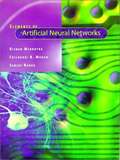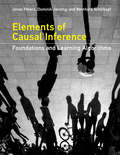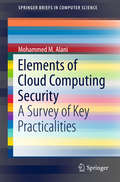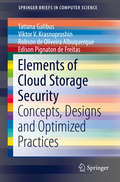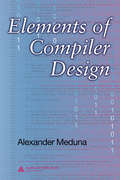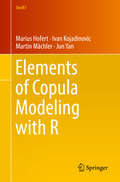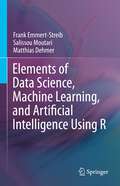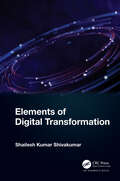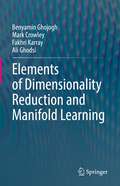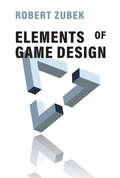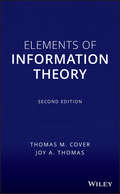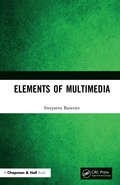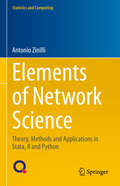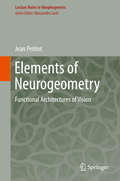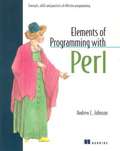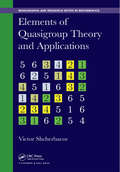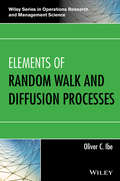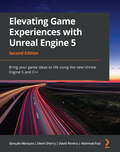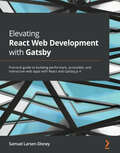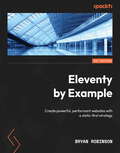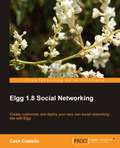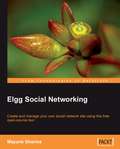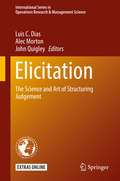- Table View
- List View
Elements of Artificial Neural Networks
by Kishan Mehrotra Chilukuri K. Mohan Sanjay RankaElements of Artificial Neural Networks provides a clearly organized general introduction, focusing on a broad range of algorithms, for students and others who want to use neural networks rather than simply study them. The authors, who have been developing and team teaching the material in a one-semester course over the past six years, describe most of the basic neural network models (with several detailed solved examples) and discuss the rationale and advantages of the models, as well as their limitations. The approach is practical and open-minded and requires very little mathematical or technical background. Written from a computer science and statistics point of view, the text stresses links to contiguous fields and can easily serve as a first course for students in economics and management. The opening chapter sets the stage, presenting the basic concepts in a clear and objective way and tackling important--yet rarely addressed--questions related to the use of neural networks in practical situations. Subsequent chapters on supervised learning (single layer and multilayer networks), unsupervised learning, and associative models are structured around classes of problems to which networks can be applied. Applications are discussed along with the algorithms. A separate chapter takes up optimization methods. The most frequently used algorithms, such as back propagation, are introduced early on, right after perceptrons, so that these can form the basis for initiating course projects. Algorithms published as late as 1995 are also included. All of the algorithms are presented using block-structured pseudo-code, and exercises are provided throughout. Software implementing many commonly used neural network algorithms is available at the book's website. Transparency masters, including abbreviated text and figures for the entire book, are available for instructors using the text.
Elements of Automata Theory
by Reuben ThomasAutomata theory lies at the foundation of computer science, and is vital to a theoretical understanding of how computers work and what constitutes formal methods. This treatise gives a rigorous account of the topic and illuminates its real meaning by looking at the subject in a variety of ways. The first part of the book is organised around notions of rationality and recognisability. The second part deals with relations between words realised by finite automata, which not only exemplifies the automata theory but also illustrates the variety of its methods and its fields of application. Many exercises are included, ranging from those that test the reader, to those that are technical results, to those that extend ideas presented in the text. Solutions or answers to many of these are included in the book.
Elements of Causal Inference: Foundations and Learning Algorithms (Adaptive Computation and Machine Learning)
by Jonas Peters Dominik Janzing Bernhard ScholkopfA concise and self-contained introduction to causal inference, increasingly important in data science and machine learning. The mathematization of causality is a relatively recent development, and has become increasingly important in data science and machine learning. This book offers a self-contained and concise introduction to causal models and how to learn them from data. After explaining the need for causal models and discussing some of the principles underlying causal inference, the book teaches readers how to use causal models: how to compute intervention distributions, how to infer causal models from observational and interventional data, and how causal ideas could be exploited for classical machine learning problems. All of these topics are discussed first in terms of two variables and then in the more general multivariate case. The bivariate case turns out to be a particularly hard problem for causal learning because there are no conditional independences as used by classical methods for solving multivariate cases. The authors consider analyzing statistical asymmetries between cause and effect to be highly instructive, and they report on their decade of intensive research into this problem. The book is accessible to readers with a background in machine learning or statistics, and can be used in graduate courses or as a reference for researchers. The text includes code snippets that can be copied and pasted, exercises, and an appendix with a summary of the most important technical concepts.
Elements of Cloud Computing Security
by Mohammed M. M. AlaniThis book offers a thorough yet easy-to-read reference guide to various aspects of cloud computing security. It begins with an introduction to the general concepts of cloud computing, followed by a discussion of security aspects that examines how cloud security differs from conventional information security and reviews cloud-specific classes of threats and attacks. A range of varying threats in cloud computing are covered, from threats of data loss and data breaches, to threats to availability and threats posed by malicious insiders. Further, the book discusses attacks launched on different levels, including attacks on the hypervisor, and on the confidentiality of data. Newer types, such as side-channel attacks and resource-freeing attacks, are also described. The work closes by providing a set of general security recommendations for the cloud.
Elements of Cloud Storage Security
by Tatiana Galibus Viktor V. Krasnoproshin Robson de Oliveira Albuquerque Edison Pignaton de FreitasThis work provides guidelines for the practical implementation of security architecture in a particular corporate cloud. The authors are mathematicians and specialists in data modeling and security. Experience of scientific collaboration with industry inspired the authors to attempt to conceptualize the common processes and strategies in cloud security, in order to make security system deployment as simple and transparent as possible. The deployment is broken into several essential steps that allow the functionality of security architecture for any cloud to be split into a set of modules. The continuous verification of security support on all levels (data, processes and communication channels) helps to avoid common security breaches and protect against the most dangerous attacks. Additionally, performing the proposed optimization of the selected set of mechanisms will enhance the efficiency of the security system.
Elements of Compiler Design
by Alexander MedunaMaintaining a balance between a theoretical and practical approach to this important subject, Elements of Compiler Design serves as an introduction to compiler writing for undergraduate students. From a theoretical viewpoint, it introduces rudimental models, such as automata and grammars, that underlie compilation and its essential phases. Based on
Elements of Copula Modeling with R (Use R!)
by Marius Hofert Ivan Kojadinovic Martin Mächler Jun YanThis book introduces the main theoretical findings related to copulas and shows how statistical modeling of multivariate continuous distributions using copulas can be carried out in the R statistical environment with the package copula (among others). Copulas are multivariate distribution functions with standard uniform univariate margins. They are increasingly applied to modeling dependence among random variables in fields such as risk management, actuarial science, insurance, finance, engineering, hydrology, climatology, and meteorology, to name a few. In the spirit of the Use R! series, each chapter combines key theoretical definitions or results with illustrations in R. Aimed at statisticians, actuaries, risk managers, engineers and environmental scientists wanting to learn about the theory and practice of copula modeling using R without an overwhelming amount of mathematics, the book can also be used for teaching a course on copula modeling.
Elements of Data Science, Machine Learning, and Artificial Intelligence Using R
by Matthias Dehmer Frank Emmert-Streib Salissou MoutariThe textbook provides students with tools they need to analyze complex data using methods from data science, machine learning and artificial intelligence. The authors include both the presentation of methods along with applications using the programming language R, which is the gold standard for analyzing data. The authors cover all three main components of data science: computer science; mathematics and statistics; and domain knowledge. The book presents methods and implementations in R side-by-side, allowing the immediate practical application of the learning concepts. Furthermore, this teaches computational thinking in a natural way. The book includes exercises, case studies, Q&A and examples.
Elements of Digital Transformation
by Shailesh Kumar ShivakumarElements of Digital Transformation is a practitioner’s guide to the digital transformation process. It is also a guide for managers in today’s organizations that are accelerating digital transformation to modernize core technology capabilities and processes. The book discusses such key components of digital transformation as processes, principles and proven methods. It also covers such novel concepts in digital transformation as the first-time right framework, incident management transformation, digital factory, cloud migration, API-first approach and legacy modernization. Other highlights of the book include: A cloud migration framework along with a cloud migration methodology, rollout strategy and migration principles Principles and approaches for legacy modernization and process modernization Smart ticket management, smart problem management, proactive maintenance and ticket-avoidance architecture The novel digital factory approach to automate the software process Detailed case studies, a sample digital transformation exercise and a consulting exercise for digital transformation provide readers with real-world digital transformation scenarios and best practices. The book also discusses DevOps, automation and agile delivery models that help in digital transformation.
Elements of Dimensionality Reduction and Manifold Learning
by Mark Crowley Fakhri Karray Benyamin Ghojogh Ali GhodsiDimensionality reduction, also known as manifold learning, is an area of machine learning used for extracting informative features from data for better representation of data or separation between classes. This book presents a cohesive review of linear and nonlinear dimensionality reduction and manifold learning. Three main aspects of dimensionality reduction are covered: spectral dimensionality reduction, probabilistic dimensionality reduction, and neural network-based dimensionality reduction, which have geometric, probabilistic, and information-theoretic points of view to dimensionality reduction, respectively. The necessary background and preliminaries on linear algebra, optimization, and kernels are also explained to ensure a comprehensive understanding of the algorithms.The tools introduced in this book can be applied to various applications involving feature extraction, image processing, computer vision, and signal processing. This book is applicable to a wide audience who would like to acquire a deep understanding of the various ways to extract, transform, and understand the structure of data. The intended audiences are academics, students, and industry professionals. Academic researchers and students can use this book as a textbook for machine learning and dimensionality reduction. Data scientists, machine learning scientists, computer vision scientists, and computer scientists can use this book as a reference. It can also be helpful to statisticians in the field of statistical learning and applied mathematicians in the fields of manifolds and subspace analysis. Industry professionals, including applied engineers, data engineers, and engineers in various fields of science dealing with machine learning, can use this as a guidebook for feature extraction from their data, as the raw data in industry often require preprocessing.The book is grounded in theory but provides thorough explanations and diverse examples to improve the reader’s comprehension of the advanced topics. Advanced methods are explained in a step-by-step manner so that readers of all levels can follow the reasoning and come to a deep understanding of the concepts. This book does not assume advanced theoretical background in machine learning and provides necessary background, although an undergraduate-level background in linear algebra and calculus is recommended.
Elements of Game Design
by Robert ZubekAn introduction to the basic concepts of game design, focusing on techniques used in commercial game production.This textbook by a well-known game designer introduces the basics of game design, covering tools and techniques used by practitioners in commercial game production. It presents a model for analyzing game design in terms of three interconnected levels--mechanics and systems, gameplay, and player experience--and explains how novice game designers can use these three levels as a framework to guide their design process. The text is notable for emphasizing models and vocabulary used in industry practice and focusing on the design of games as dynamic systems of gameplay.
Elements of Information Theory
by Thomas M. Cover Joy A. ThomasThe latest edition of this classic is updated with new problem sets and materialThe Second Edition of this fundamental textbook maintains the book's tradition of clear, thought-provoking instruction. Readers are provided once again with an instructive mix of mathematics, physics, statistics, and information theory.All the essential topics in information theory are covered in detail, including entropy, data compression, channel capacity, rate distortion, network information theory, and hypothesis testing. The authors provide readers with a solid understanding of the underlying theory and applications. Problem sets and a telegraphic summary at the end of each chapter further assist readers. The historical notes that follow each chapter recap the main points.The Second Edition features:* Chapters reorganized to improve teaching* 200 new problems* New material on source coding, portfolio theory, and feedback capacity* Updated referencesNow current and enhanced, the Second Edition of Elements of Information Theory remains the ideal textbook for upper-level undergraduate and graduate courses in electrical engineering, statistics, and telecommunications.An Instructor's Manual presenting detailed solutions to all the problems in the book is available from the Wiley editorial department.
Elements of Multimedia
by Sreeparna BanerjeeElements of Multimedia presents a systematic introduction and integrated overview of the state-of-the-art innovations that make Multimedia a rapidly evolving technology in the digital domain. This book is also an invaluable resource for applied researchers. Some of the salient features of the book include: <P><P> <li>Overview of recent additions to multimedia like New Media, Digital Media, Social Media and Mobile Media. <li>This book provides a starting point for researchers wishing to pursue research in Multimedia. <li>Discussions on advances in Web Technology, particularly Web 2.0, as well as Multimedia Applications. <li>Detailed descriptions on different Multimedia elements like text, graphics, images, audio, video and animation. <li>Introduction to the concepts of data compression. <li>Various aspects of multimedia presentations. <li>Multimedia storage hardware. <li>Databases for Multimedia data storage and indexing schemes for accessing Multimedia data. <li>Multimedia communications and networking issues. <P><P>Each chapter ends with a review of the topics covered and a set of review questions to enable the student to go back to the chapter and recapitulate the subject matter. Answers to the Multiple-Choice Questions (MCQ) are provided at the end of the book. Solutions of problems are also provided.
Elements of Network Science: Theory, Methods and Applications in Stata, R and Python (Statistics and Computing)
by Antonio ZinilliThis book provides readers with a comprehensive guide to designing rigorous and effective network science tools using the statistical software platforms Stata, R, and Python. Network science offers a means to understand and analyze complex systems that involve various types of relationships. This text bridges the gap between theoretical understanding and practical application, making network science more accessible to a wide range of users. It presents the statistical models pertaining to individual network techniques, followed by empirical applications that use both built-in and user-written packages, and reveals the mathematical and statistical foundations of each model, along with demonstrations involving calculations and step-by-step code implementation. In addition, each chapter is complemented by a case study that illustrates one of the several techniques discussed. The introductory chapter serves as a roadmap for readers, providing an initial understanding of network science and guidance on the required packages, the second chapter focuses on the main concepts related to network properties. The next two chapters present the primary definitions and concepts in network science and various classes of graphs observed in real contexts. The final chapter explores the main social network models, including the family of exponential random graph models. Each chapter includes real-world data applications from the social sciences, using at least one of the platforms Stata, R, and Python, providing a more comprehensive understanding of the availability of network science methods across different software platforms. The underlying computer code and data sets are available online. The book will appeal to graduate students, researchers and data scientists, mainly from the social sciences, who seek theoretical and applied tools to implement network science techniques in their work.
Elements of Neurogeometry
by Jean PetitotThis book describes several mathematical models of the primary visual cortex, referring them to a vast ensemble of experimental data and putting forward an original geometrical model for its functional architecture, that is, the highly specific organization of its neural connections. The book spells out the geometrical algorithms implemented by this functional architecture, or put another way, the "neurogeometry" immanent in visual perception. Focusing on the neural origins of our spatial representations, it demonstrates three things: firstly, the way the visual neurons filter the optical signal is closely related to a wavelet analysis; secondly, the contact structure of the 1-jets of the curves in the plane (the retinal plane here) is implemented by the cortical functional architecture; and lastly, the visual algorithms for integrating contours from what may be rather incomplete sensory data can be modelled by the sub-Riemannian geometry associated with this contact structure. As such, it provides readers with the first systematic interpretation of a number of important neurophysiological observations in a well-defined mathematical framework. The book's neuromathematical exploration appeals to graduate students and researchers in integrative-functional-cognitive neuroscience with a good mathematical background, as well as those in applied mathematics with an interest in neurophysiology.
Elements of Programming with Perl
by Andrew JohnsonMany neophyte programmers now begin their careers by learning the metalanguage, Perl. But the books currently available on Perl assume their readers already understand the basics of writing and designing programs--when in fact they do not. The tutorial teaches programming right along with the particulars of Perl syntax, as well as good style and structure and maintainability of the code.
Elements of Quasigroup Theory and Applications (Chapman & Hall/CRC Monographs and Research Notes in Mathematics)
by Victor ShcherbacovThis book provides an introduction to quasigroup theory along with new structural results on some of the quasigroup classes. Many results are presented with some of them from mathematicians of the former USSR. These included results have not been published before in the western mathematical literature. In addition, many of the achievements obtained with regard to applications of quasigroups in coding theory and cryptology are described.
Elements of Random Walk and Diffusion Processes
by Oliver C. IbePresents an important and unique introduction to random walk theoryRandom walk is a stochastic process that has proven to be a useful model in understanding discrete-state discrete-time processes across a wide spectrum of scientific disciplines. Elements of Random Walk and Diffusion Processes provides an interdisciplinary approach by including numerous practical examples and exercises with real-world applications in operations research, economics, engineering, and physics.Featuring an introduction to powerful and general techniques that are used in the application of physical and dynamic processes, the book presents the connections between diffusion equations and random motion. Standard methods and applications of Brownian motion are addressed in addition to Levy motion, which has become popular in random searches in a variety of fields. The book also covers fractional calculus and introduces percolation theory and its relationship to diffusion processes.With a strong emphasis on the relationship between random walk theory and diffusion processes, Elements of Random Walk and Diffusion Processes features:Basic concepts in probability, an overview of stochastic and fractional processes, and elements of graph theoryNumerous practical applications of random walk across various disciplines, including how to model stock prices and gambling, describe the statistical properties of genetic drift, and simplify the random movement of molecules in liquids and gasesExamples of the real-world applicability of random walk such as node movement and node failure in wireless networking, the size of the Web in computer science, and polymers in physicsPlentiful examples and exercises throughout that illustrate the solution of many practical problemsElements of Random Walk and Diffusion Processes is an ideal reference for researchers and professionals involved in operations research, economics, engineering, mathematics, and physics. The book is also an excellent textbook for upper-undergraduate and graduate level courses in probability and stochastic processes, stochastic models, random motion and Brownian theory, random walk theory, and diffusion process techniques.
Elevating Game Experiences with Unreal Engine 5: Bring your game ideas to life using the new Unreal Engine 5 and C++
by Devin Sherry David Pereira Hammad Fozi Gonçalo MarquesGet hands-on with game development tools and techniques to build a game project using the latest version of Unreal Engine and C++, two of the most widely used tools in the game industryKey FeaturesKickstart your career or develop a new hobby by learning game development with Unreal Engine 5 and C++Learn techniques to prototype and develop your own ideas with key images printed in colorReinforce your skills with project-based learning by building a series of games from scratchBook DescriptionImmerse yourself in the Unreal game projects with this book, written by four highly experienced industry professionals with many years of combined experience with Unreal Engine. Elevating Game Experiences with Unreal Engine 5 will walk you through the latest version of Unreal Engine by helping you get hands-on with the game creation projects. The book starts with an introduction to the Unreal Editor and key concepts such as actors, blueprints, animations, inheritance, and player input. You'll then move on to the first of three projects, building a dodgeball game, where you'll learn the concepts of line traces, collisions, projectiles, user interface, and sound effects. You’ll also discover how to combine these concepts to showcase your new skills. The second project, a side-scroller game, will help you implement concepts such as animation blending, enemy AI, spawning objects, and collectibles. And finally, you'll cover the key concepts in creating a multiplayer environment as you work on the third project, an FPS game. By the end of this Unreal Engine book, you'll have a broad understanding of how to use the tools that the game engine provides to start building your own games.What you will learnCreate a fully functional third-person character and enemiesImplement navigation with keyboard, mouse, and gamepadProgram logic and game mechanics with collision and particle effectsExplore AI for games with Blackboards and behavior treesBuild character animations with animation blueprints and montagesPolish your game with stunning visual and sound effectsExplore the fundamentals of game UI using a heads-up displayDiscover how to implement multiplayer in your gamesWho this book is forThis book is for game developers looking to get started with using Unreal Engine 5 for their game development projects. Anyone who has used Unreal Engine before and wants to consolidate, improve, and apply their skills will find this book useful. To better grasp the concepts explained in this book, prior knowledge of C++ basics such as variables, functions, classes, polymorphism, and pointers is required. For full compatibility with the IDE used in this book, a Windows system is recommended
Elevating Game Experiences with Unreal Engine 5: Bring your game ideas to life using the new Unreal Engine 5 and C++, 2nd Edition
by Goncalo Marques Devin Sherry David Pereira Hammad FoziGet hands-on with game development tools and techniques to build game project using the latest version of Unreal Engine and C++, two of the most widely used tools in the games industryKey FeaturesKickstart your career or develop a new hobby by learning game development with Unreal Engine 5 and C++Learn techniques to prototype and develop your own ideas with key images printed in colorReinforce your skills with project-based learning by building a series of games from scratchBook DescriptionImmerse yourself in the Unreal game projects with this book, written by four highly experienced industry professionals with many years of combined experience with Unreal Engine. Elevating Game Experiences with Unreal Engine 5 will walk you through the latest version of Unreal Engine by helping you get hands-on with the game creation projects. The book starts with an introduction to the Unreal Editor and key concepts such as actors, blueprints, animations, inheritance, and player input. You'll then move on to the first of three projects, building a dodgeball game, where you'll learn the concepts of line traces, collisions, projectiles, user interface, and sound effects. You'll also discover how to combine these concepts to showcase your new skills. The second project, a side-scroller game, will help you implement concepts such as animation blending, enemy AI, spawning objects, and collectibles. And finally, you'll cover the key concepts in creating a multiplayer environment as you work on the third project, an FPS game. By the end of this Unreal Engine book, you'll have a broad understanding of how to use the tools that the game engine provides to start building your own games.What you will learnCreate a fully functional third-person character and enemiesImplement navigation with keyboard, mouse, and gamepadProgram logic and game mechanics with collision and particle effectsExplore AI for games with Blackboards and behavior treesBuild character animations with animation blueprints and montagesPolish your game with stunning visual and sound effectsExplore the fundamentals of game UI using a heads-up displayDiscover how to implement multiplayer in your gamesWho this book is forThis book is for game developers looking to get started with using Unreal Engine 5 for their game development projects. Anyone who has used Unreal Engine before and wants to consolidate, improve, and apply their skills will find this book useful. To better grasp the concepts explained in this book, prior knowledge of C++ basics such as variables, functions, classes, polymorphism, and pointers is required. For full compatibility with the IDE used in this book, a Windows system is recommended
Elevating React Web Development with Gatsby: Practical guide to building performant, accessible, and interactive web apps with React and Gatsby.js 4
by Samuel Larsen-DisneyLearn how to create SEO-friendly, powerful static websites using Gatsby by harnessing the power of ReactKey FeaturesUnderstand how to use Gatsby to build, test, and deploy an end-to-end website and manage SEOBuild reusable templates to streamline your workflowsCreate plugins, add authentication, and work with real-time dataBook DescriptionGatsby is a powerful React static site generator that enables you to create lightning-fast web experiences. With the latest version of Gatsby, you can combine your static content with server-side rendered and deferred static content to create a fully rounded application. Elevating React Web Development with Gatsby provides a comprehensive introduction for anyone new to GatsbyJS and will help you get up to speed in no time.Complete with hands-on tutorials and projects, this easy-to-follow guide starts by teaching you the core concepts of GatsbyJS. You'll then discover how to build performant, accessible, and scalable websites with the GatsbyJS framework. Once you've worked through the practical projects in the book, you'll be able to build anything from a personal website to large-scale applications with authentication and make your site rise through those SEO rankings.By the end of this Gatsby development book, you'll be well-versed in every aspect of the tool's performance and accessibility and have learned how to build client websites that your users will love.What you will learnUnderstand what GatsbyJS is, where it excels, and how to use itStructure and build a GatsbyJS site with confidenceElevate your site with an industry-standard approach to stylingConfigure your GatsbyJS projects with search engine optimization to improve their rankingGet to grips with advanced GatsbyJS concepts to create powerful and dynamic sitesSupercharge your site with translations for a global audienceDiscover how to use third-party services that provide interactivity to usersWho this book is forThis book is for web developers who want to use GatsbyJS with React to build better static and dynamic client-side apps. Prior experience of working with React basics is necessary. Knowledge of Node.js fundamentals will help you to get the most out of this web development book.
Eleventy by Example: Create powerful, performant websites with a static-first strategy
by Bryan RobinsonBuild faster static sites by leveraging CDN and creating custom tools and workflows with 5 real-world projectsPurchase of the print or Kindle book includes a free PDF eBookKey FeaturesLearn how to use and extend 11ty, one of the most flexible static site generators in the industry.Optimize your experience by customizing 11ty to suit various projects' needsCreate request-time experiences without recreating templates with 11ty ServerlessBook Description11ty is the dark horse of the Jamstack world, offering unparalleled flexibility and performance that gives it an edge against other static site generators such as Jekyll and Hugo. With it, developers can leverage the complete Node ecosystem and create blazing-fast, static-first websites that can be deployed from a content delivery network or a simple server. This book will teach you how to set up, customize, and make the most of 11ty in no time. Eleventy by Example helps you uncover everything you need to create your first 11ty website before diving into making more complex sites and extending 11ty's base functionality with custom short codes, plugins, and content types. Over the course of 5 interactive projects, you'll learn how to build basic websites, blogs, media sites, and static sites that will respond to user input without the need for a server. With these, you'll learn basic 11ty skills such as templates, collections, and data use, along with advanced skills such as plugin creation, image manipulation, working with a headless CMS, and the use of the powerful 11ty Serverless plugin. By the end of this book, you'll be well-equipped to leverage the capabilities of 11ty by implementing best practices and reusable techniques that can be applied across multiple projects, reducing the website launch time.What you will learnCreate a basic website with reusable templates and globally available dataBuild a blog using 11ty's collectionsSet up a photography site that uses the 11ty Image plugin to deploy properly sized imagesConnect a content management system to provide an enhanced editor and developer experienceModel an enhanced search experience with no dedicated server through serverless functions and 11ty ServerlessBoost productivity by creating custom 11ty tools and pluginsWho this book is forThis book is for anyone looking to build efficient websites while shipping less JavaScript to the client. Strong knowledge of HTML and CSS and beginner-level knowledge of JavaScript and the Node.js ecosystem, including querying APIs is a must.
Elgg 1.8 Social Networking
by Cash CostelloThis book provides more than just a step-by-step guide to installing and using Elgg. It includes practical advice gained through experience on what it takes to deploy and maintain an Elgg-based site. If you are a software developer or are familiar with PHP, it provides both a tutorial-based introduction and a quick reference guide so that you can quickly extend and customize Elgg. If you want to create a social networking site using Elgg and do not have a background in software development, this book provides all the information and advice that you need written just for you. If you are a developer, it also contains valuable tutorials and reference material so that you can begin writing code right away.
Elgg Social Networking
by Mayank SharmaThis book has a very easy-to-follow approach that will teach you how to do things with examples and lots of screenshots. As an example the book builds a community site for Linux administrators. This book is aimed at people interested in social networking and e-learning teachers.
Elicitation
by John Quigley Alec Morton Luis C. DiasThis book is about elicitation: the facilitation of the quantitative expression of subjective judgement about matters of fact, interacting with subject experts, or about matters of value, interacting with decision makers or stakeholders. It offers an integrated presentation of procedures and processes that allow analysts and experts to think clearly about numbers, particularly the inputs for decision support systems and models. This presentation encompasses research originating in the communities of structured probability elicitation/calibration and multi-criteria decision analysis, often unaware of each other's developments. Chapters 2 through 9 focus on processes to elicit uncertainty from experts, including the Classical Method for aggregating judgements from multiple experts concerning probability distributions; the issue of validation in the Classical Method; the Sheffield elicitation framework; the IDEA protocol; approaches following the Bayesian perspective; the main elements of structured expert processes for dependence elicitation; and how mathematical methods can incorporate correlations between experts. Chapters 10 through 14 focus on processes to elicit preferences from stakeholders or decision makers, including two chapters on problems under uncertainty (utility functions), and three chapters that address elicitation of preferences independently of, or in absence of, any uncertainty elicitation (value functions and ELECTRE). Two chapters then focus on cross-cutting issues for elicitation of uncertainties and elicitation of preferences: biases and selection of experts. Finally, the last group of chapters illustrates how some of the presented approaches are applied in practice, including a food security case in the UK; expert elicitation in health care decision making; an expert judgement based method to elicit nuclear threat risks in US ports; risk assessment in a pulp and paper manufacturer in the Nordic countries; and elicitation of preferences for crop planning in a Greek region.
